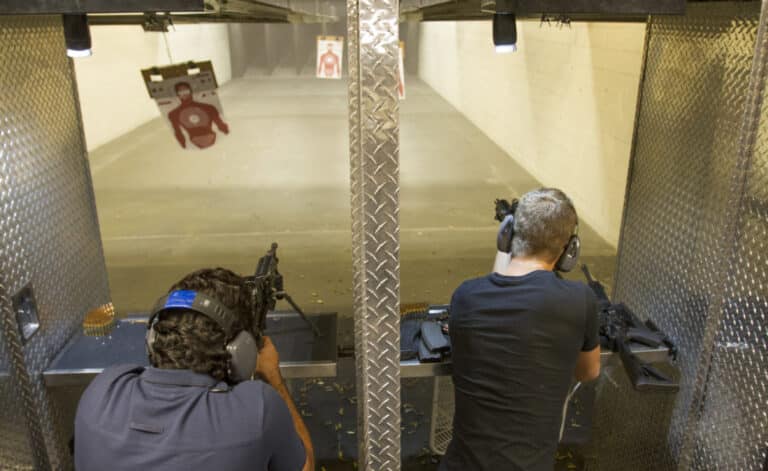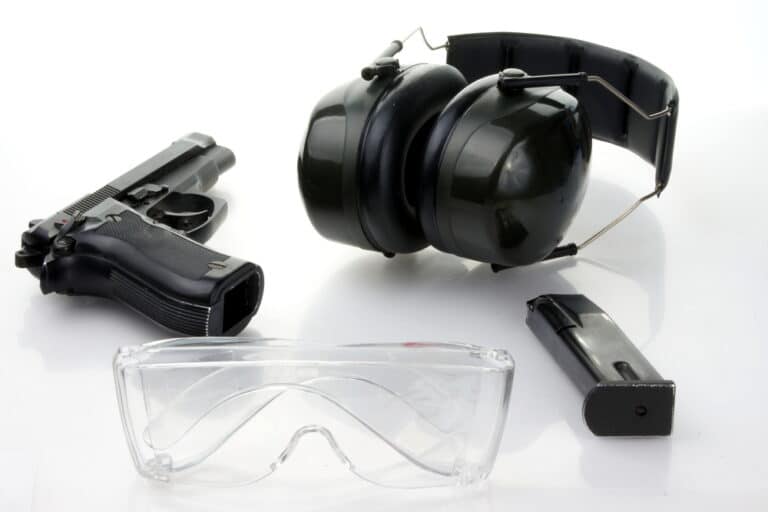How To Properly Shoot A Pistol

Pistols are excellent for self-defense and even recreational purposes. However, handling one is a huge responsibility. After all, a handgun is not a toy.
Learning how to properly shoot a pistol is essential to gun safety and being able to effectively defend your family in a worst-case scenario. In this article, we’ll break down some of the fundamentals of properly handling and shooting a handgun. Continue reading to learn how to properly shoot a handgun.
Before trying any of the below, first ensure that your handgun is unloaded (no loaded magazine is inserted and the chamber is empty). Safety first, fun stuff second.
Properly gripping a pistol
As you can imagine, grip is extremely important when shooting a handgun. Your goal when gripping a pistol should be to maintain positive control of the firearm while absorbing recoil and mitigating muzzle flip (the front of the barrel rising after a shot due to the force of the shot and the rearward motion of the slide). Ultimately, due to the differing sizes of shooters’ hands and differing sizes of pistols and their grips, there is no one grip that is the universal “right” one. Experiment with the below and find the grip that works best for your hands and the firearm you’re using.
Hold the pistol in your dominant hand with your middle, ring and pinky fingers as high on the grip under the trigger guard as possible, with the gap between your thumb and index finger as high as possible under the rear of the slide without being in the way of the slide’s rearward movement. Your index finger should run alongside the slide, and your thumb should rest along the frame of the pistol, with the tip of your thumb pointing in the same direction as the barrel. Generally, you want to put as few rotational forces on the pistol as possible, so using this grip you should be squeezing the pistol between the base of your palm and your fingers in a direction that aligns with the front and rear of the pistol – position your hand so that you’re not ‘twisting’ the grip when you squeeze.
With your dominant / firing hand locked in, wrap your other (support) hand around the middle, ring and pinky fingers of your dominant hand. The goal with the support hand is to help secure the frame of the pistol. Depending on how big your hands are and the size of the pistol, you’ll want to make sure that any part of the grip that isn’t covered by your dominant / firing hand is covered by your support hand. This usually means you’ll want to rotate your support hand forward to engage the open part of the frame with the base of the support hand’s palm. Your support hand thumb can then rest parallel or on top of your dominant / firing thumb.When locking in your grip, note that your thumbs aren’t going to be squeezing much – you’ll mostly be using your fingers and palms.
Shooting stances
Shooting a handgun accurately also requires having a steady stance. If you’re not planted and holding your weapon properly, you won’t be ready for the recoil, which is the force transmitted rearwards from the small explosion you’re setting off in the pistol’s chamber. Recoil differs from muzzle rise or muzzle flip, which is caused by gas exiting the barrel and the rapid shift rearward of the gun’s center of gravity as the slide is blown back.
Having a proper stance makes it easier to aim and control your firearm. Even if you’re a somewhat experienced shooter and want to know how to be a better shot, the details are often in the stance. In this section, we’ll talk about several of the most common shooting stances and their strengths and weaknesses.
Power Isosceles Stance
The power isosceles stance is the stance of shooting competition champs. It’s a modification of the near-ancient isosceles stance. Many shooters prefer this stance because it is simple and feels natural, especially if you’ve ever done any kind of martial arts or boxing.
To assume the isosceles stance, stand up straight, knees slightly bent and locked, and squarely facing your target with your feet spread shoulder-width apart. Raise the gun to your eye level and fully extend both arms. This is the original isosceles stance. The ‘power’ comes into the stance when you move the shooting side foot back 8-10 inches and unlock the knees. Think about how you would square up to an opponent to throw a punch – this stance should be very similar to that.
The best thing about the power isosceles is that you gain stability and recoil control without losing any of the advantages of the original isosceles stance, including:
- Quicker stance to assume than the Chapman stance with less practice than the Weaver stance.
- Increased peripheral vision – since you square off to your target
- Easier aiming for cross-dominant shooters than the Weaver and Chapman stances.
Weaver Stance
The Weaver stance was by far the most popular stance taught to shooters over the last couple of decades, from Law Enforcement to competition shooters. As we describe it here, you might even recognize it as the one you see most from the heroes in action movies.
To assume the Weaver stance, bring the foot on your non-shooting side 8-10 inches in front of the other one, with your toes pointed toward the target. Your shooting-side foot should be turned slightly outward at a 45-degree angle.
Grip the gun with both hands, and keep your strong arm (the shooting arm) slightly bent. Your support arm should be bent at the elbow at a 45-degree downward angle from your strong arm.
To form a secure grip, the support hand pulls into the shooter while the strong hand pushes slightly outward toward the intended target.
Advantages of Weaver Stance
- Easy stance to assume with time and practice.
- Very stable stance, if you have the arm and back strength to maintain it.
- Improves accuracy by bringing sights in closer.
Disadvantages
- Requires arm, wrist and shoulder/back strength to maintain a proper stance.
- Puts a considerable amount of stress on your strong side shoulder and back.
- Not ideal if your dominant hand and eye are on opposite sides.
Chapman Stance
Another of the most popular stances is the Chapman stance, which is actually a variation of the Weaver stance. The biggest difference is that in the Chapman stance, both arms are fully extended, and the support-side foot isn’t placed as far forward. Essentially, your shooting-side arm acts as a rifle stock, and some people even rest their jaw on their upper arm, which brings the sights closer.
Advantages of Chapman Stance
- Easier to assume for people with less upper-body strength than the Weaver stance.
- More relaxed than the Weaver stance.
- Easier to aim for people with cross-dominant vision (dominant hand and eye on opposite sides).
Disadvantages
- Not as quick of a stance to assume as the Weaver stance.
- Provides a short range of motion.
- Sights farther away due to full arm extension.
Aiming a pistol
Now that you know how to properly grip a pistol and you’ve learned about some of the best stances to assume when shooting, you’re ready to learn about aiming a gun. As you learned in the previous section, your stance has a lot to do with the accuracy of your shot. But, now it’s time to set our sights on — well — the sights.
Most handguns are fitted with Patridge sights, consisting of a rectangular rear sight with either a U or rectangular-shaped gap. These sights are commonly referred to as ‘iron sights’ or ‘irons’. The gap in the rear sight should be aligned so that the square front sight is centered and level between the two rear sight posts, which is known as sight alignment. Proper sight alignment should look like an upside-down ‘m’.
Your sight picture is what you see when you aim the front sight at your intended target. Always focus on the front sight when shooting. Use your dominant eye to focus on the front sight, which you aim at the intended target. Your front sight should be in focus, with the rear sights and your target slightly fuzzy. You can keep your other eye open or closed, whichever feels best for you. With iron sights, many shooters prefer to close their other eye to better focus on the front sight, but this does reduce peripheral vision and overall situational awareness.
When learning how to aim a pistol, there are two different “holds” you can use for aligning your sights with your intended target. One of those is known as the “6 o’clock” hold, and the other, more common hold, is the center hold.
When applying the 6 o’clock hold, you align your sight picture so that the top of the front sight is at the bottom edge of your intended target — just like the 6 on a clock. The center hold is exactly what its name suggests. When using that aiming method, you align your sight picture so your front and rear sights are in the center of your intended target.
If you’re using a pistol optic, commonly referred to as a ‘red dot’ or ‘dot’, then ignore everything previously written in this section. Most pistol optics project light onto a clear medium, usually red, though sometimes green or gold. When aiming with a red dot, instead of focusing on the dot, you should focus on the target, and bring the dot to where you’re focusing. It’s also recommended to keep both eyes open.
Squeezing the trigger
Once you know how to aim a pistol, you’re ready to learn how to shoot. Let’s begin with trigger finger placement.
When squeezing the trigger, only the two joints closest to the tip of your finger should move. Many shooting experts agree that you should place your finger so that the trigger is between the first two joints but closer to the first one nearest your fingertip. This will give you better control when you squeeze the trigger.
We say “squeeze” the trigger because one of the most common mistakes people make when shooting is their trigger press. Going too fast and ‘jerking’ the trigger will pull the entire pistol out of alignment and result in your rounds being off target. Your trigger squeeze should be consistent rearward pressure until the gun fires, a proper trigger press should almost be a surprise to you when you reach the break.
After the shot, as you release pressure on the trigger, you will feel and hear a click – this is called the reset, and signifies that the trigger has moved far enough forward to be ready to fire another round. For faster follow-up shots, keep your trigger at this position and you’re ready to begin another trigger press. Do not throw your finger forward after the shot, you should maintain contact with the trigger unless you’re done shooting.
Improving your shot
Learning pistol shooting tips is great. However, the only way to ingrain them as habits is through practice. The more shooting experiences you have, the more competent and confident you’ll become shooting a handgun.
Dry firing
A great way to get some practice in without using live ammo is dry firing. Dry firing is when you practice pulling the trigger without live rounds. Remember, before you dry fire your pistol, check your owner’s manual to make sure it’s okay. It’s fine with most centerfire pistols, but you should never do so with a rimfire handgun or rifle.
Whenever you’re handling a firearm, gun safety is the most important thing to remember, even if you think the gun is empty. Always check to make sure your gun is unloaded before practicing your trigger pulling. It’s even a good idea to check to make sure there are no cartridges in your pistol between dry fires to get into the habit.
Range shooting
Dry firing is an effective way to get used to pulling the trigger and refining your grip and reaction to pulling the trigger. However, nothing beats time at the firing range for improving your shot.
The great thing about going to the range is you can get instruction from experts who can walk you through all the basics of becoming competent with a pistol. It’s also a good way to meet other people who are working on their shooting as well.
Practice makes perfect
These pistol shooting tips will help you understand the fundamentals of shooting, but ultimately, practice makes perfect. You can become an expert shooter with time and effort.
The more fun learning something new is, the easier it is to commit to it. That’s why we offer a wide variety of shooting experiences and training for beginners, concealed carry, and armed security. Round for round, The Range 702 is the best firing range in town to hone your shooting skills or have fun blowing off some steam and as many cartridges as you please.
Visit our Experiences Page to learn more about all of our different shooting experiences and special offers!





